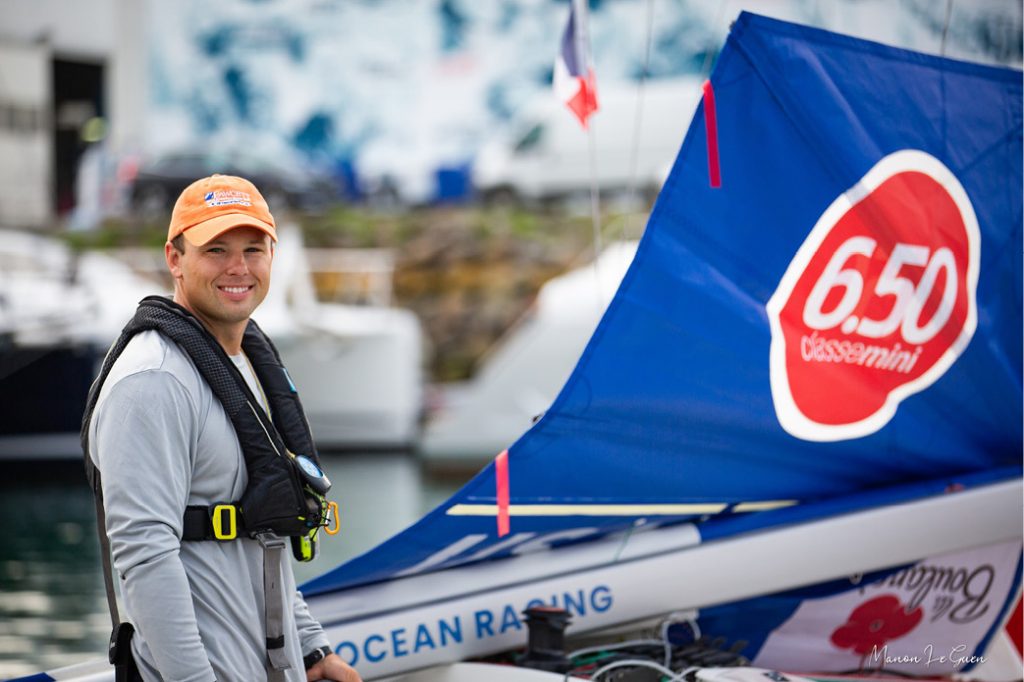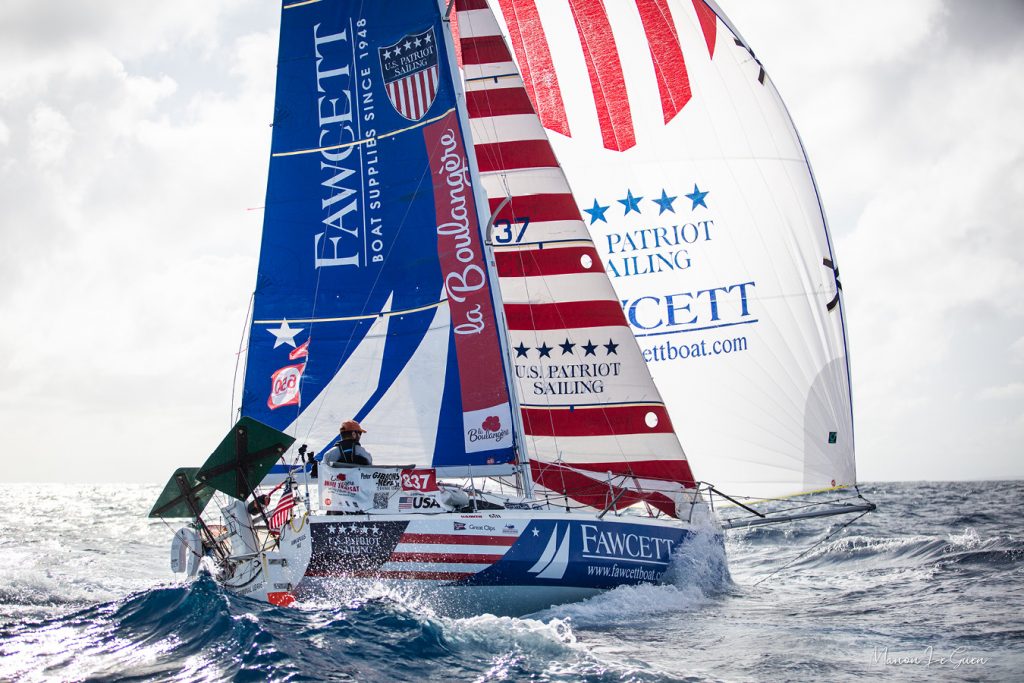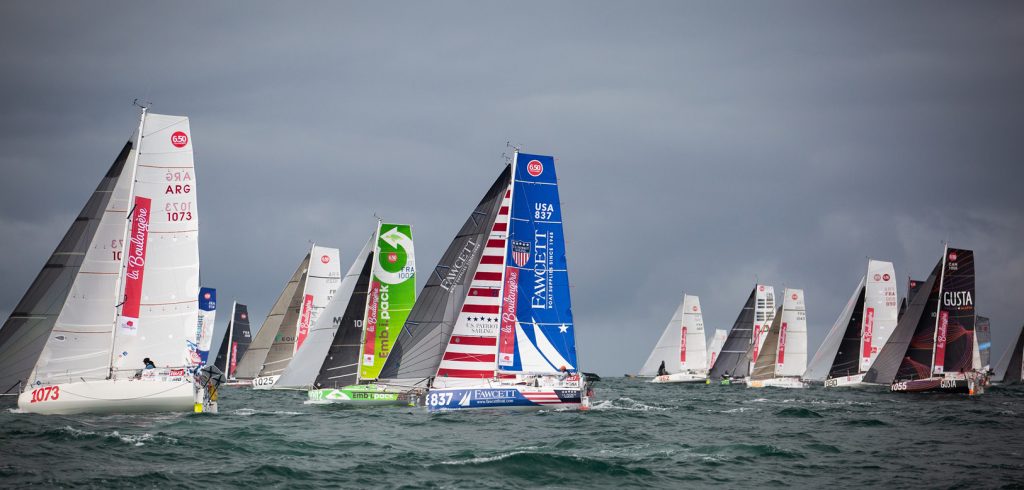Photos by Manon le Geun
Regular readers will know that Peter Gibbons-Neff recently arrived back in Annapolis after completing the 2023 Mini Transat. Finishing the race after losing a day to repair a broken rudder, his placing was not what we had all hoped for, but in such races merely finishing is a massive feat on its own. I spoke with Peter via Zoom in early January.

PGN before the start © Manon le Geun
Coop: Peter, welcome back mate. Sorry about the placing. Must be a disappointment. What happened?
PGN: I was about a week into the second leg, from Santa Cruz de la Palma in the Canary Islands to Guadeloupe. The fleet had basically split into two clusters, a northern one and a southern one. I was in the group that was heading south. This particular day, I was ripping. I had a reef in the kite, a reef in the jib, two reefs in the main, hitting 16 knots in the Tradewinds…just like you read about. I was just flying, going the fastest I had ever been on the boat. I was hand steering and I felt a jolt on the tiller. I looked out over the stern and saw the rudder just skipping along on the top of the surface. That very quickly changed everything.
Coop: What failed?
PGN: I hit something, and unfortunately this is happening more and more these days.
Coop: Could you tell that by the front of the blade?
PGN: Oh, yes. I had two big chunks out the front of the blade (holds fingers 2” apart), and they went all the way to the core of the structure. This impact tore the rudder and fittings off the hull. When I got it aboard, both sides of the fittings, the rudder gudgeons and hull fittings were on the rudder, with the pintles still in place, holding the two rudder fittings together. The bolts holding the hull gudgeons to the hull had failed. The only reason I did not lose the rudder was it was secured to the boat by the tiller arm. If that had failed, I would’ve lost the rudder. Game over.

Making knots, before sudden impact © Manon le Geun
I slowed the boat, got the sails down, stabilized the boat and was able to recover the rudder. As it turns out, the type of failure, “just” the hull side gudgeon bolts, was the reason I was able to get turned around inside the minimum compulsory 12-hour stopover rule. (Coop: Any technical stop is mandated to be a minimum of 12 hours.) I had to just reattach the hull fitting back onto the boat. There was not really any fiberglass structural failure at all.
Coop: The bolts did not pull out though the glass of the transom? I guess it’s pretty strong right there.
PGN: No. The bolts were only 6 mm diameter, and sheared off at the interface of the stainless steel fitting and the hull. The stump of thread and washers and nuts were still on the inside of the hull. That’s what made the repair, and turnaround time so fast. I just needed some bolts and Sikaflex and I was good to go. Plus fixing the dings in the rudder edge which was pretty basic.
Coop: This situation must have had your emotions running all over the lot. “Three years up the spout. What to do now? Do I try and fix this here now? Do I keep going on one rudder? Well, the Cape Verdes are kind of just back there…” What was the thought process?
PGN: I think I shut the emotions off almost immediately, just to go into troubleshooting mode. I sat and analyzed the bigger picture situation. Was there any hull damage or delamination I could not immediately see? Had any water got into the back of the boat somehow? I shut down the external emotional factors and went into problem solving mode – much like my military training. What is the problem? What are the problems outside the damage? I started almost immediately to think about focusing on solving the problem.
It was not comfortable. There were 10-foot seas, it was blowing 25 knots and the boat, with no sails up, was getting bounced around. NOT pleasant, but I had to figure out what I was going to do. I was worried that I could get whacked with a wave, knock the boat over, sustain more damage to the boat, or me…There was a lot going on considering I was dead stopped in the water, sideways to the seas. For a few seconds, the competitive me thought, ‘What would happen if I just kept going?’ Well, I still had about 2,800 miles to go, the port rudder was busted, so steering on starboard gybe, with only the starboard rudder meant I needed to keep the boat flat, so minimal sail, going slow. I thought about trying to fix the rudder out there, but that was not going to work. None of these ideas passed the sniff test.
Anyway, I got some sails back on her and gybed onto port so I had the good (only; starboard) rudder in the water. I looked at the compass and heading and realized I was pointing basically at the C. Verde archipelago: ‘OK, I’ll take that as a sign.’
Now here is a good learning experience. I knew the islands were there, but I had not really paid attention to them in any fashion let alone thought they could be a bailout port if something happened. Never even crossed my mind. In hindsight, I absolutely should have had a Plan D or so for such things, but I had not thought about the C. Verdes, because once you leave the Canaries and head southwest the next stop really is the Caribbean.
Anyway, I started researching the islands in the pilot book I had on board. This was a commercial shipping pilot book, not a cruising guide for yachts. I learned where all the 1,000-foot docks were and 100-ton cranes, but not so much for small yachts. I just needed a small marina or yard where I could get some 6 mm bolts and Sikaflex. I wanted to stop at the most north and west port I could. I was going to fix this problem and get back to it. I was not done with this race.
And I was fully prepared to arrive and find out what I wanted was not available and I needed to go “over there” to another port, harbor or island. I found a place called Porto Grande. Hummm, Big Port. OK, let’s go there. I could also clear immigration there, so I thought that was a good sign. That kind of service suggested more than a dusty commercial dock.
Anyway, Jane, my girlfriend and massive supporter, had been searching around the islands too, and got a hold of some guys in the boat repair biz on the island in that port. They were ready for me to arrive, and on a weekend too! And get this. As I arrived, I saw a bunch of cruising boats. They were with a rally from the Vendee region, where the race starts, and were all French boats. They know Minis, and were all over asking, “Hey, you OK?” and so on. For a while I was in the limelight. That was pretty funny.
Coop: How did the Mini Transat come onto your radar?
PGN: It’s kind of a long story. I was in the military and living in Annapolis. I was towards my last years and they were at the Pentagon. I had been out of racing for about ten years, while I was full time in the military. I had been all around the U.S., deployed overseas and so on. I went from no sailing back to Annapolis and started sailing three or four days a week. A lot of that was volunteering with U.S. Patriot Sailing. I was doing a lot of racing around Annapolis, racing with the Team in a J/22 in Baltimore. It was great to be back in sailing and seeing guys I had not seen for a decade. When I was at the Naval Academy, I was sailing six days a week on the Offshore Team.
I was getting ready to transition out of the military, but I was going into the Reserves and did not want to leave the service completely. Of course, about a year out from this planned transition, COVID shut the world down. The only sailing that was sort of going on was the prep for the 2020 Vendee Globe, so I started following that, the sailing, the boats, and the training those guys were doing.

Start of Leg 1 © Manon le Geun
I was following the initiatives of the proposed DH class in the Olympics. I could see that the trend was towards shorthanded, doublehanded and particularly solo, in Europe, especially France. But I did not of course have money for an IMOCA, and Class40s are not really that budget friendly, so I started looking further afield. I found the Mini Transat, and the idea of this race and the boats spiked my interest.
It’s a relatively affordable race, it’s offshore racing, and being solo meant COVID was less of a problem. I went from thinking about it to doing some research on the boats. At the time I could not just fly to France and look at Minis for sale, but I discovered there was a Mini down the street, in Annapolis. I went and looked at it and I fell in love. I found out it had done two Bermuda 1-2s. I really liked the way it looked, and I could walk to it from my condo. Things were starting to open up that summer of 2020, and by August I was really considering doing the Mini Transat. By September, I had bought her. From then on, the second the check cleared, I was 100% committed to doing the Mini Transat. ■
Look for the second half of Coop’s conversation with PGN in our March edition.
